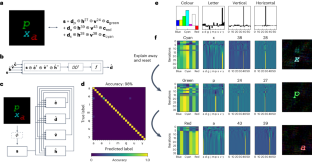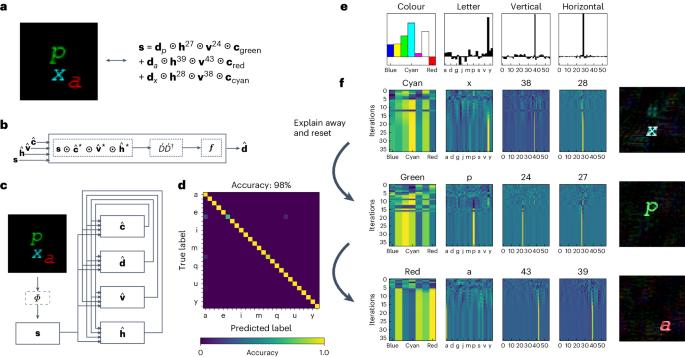Neuromorphic visual scene understanding with resonator networks
IF 18.8
1区 计算机科学
Q1 COMPUTER SCIENCE, ARTIFICIAL INTELLIGENCE
引用次数: 0
Abstract
Analysing a visual scene by inferring the configuration of a generative model is widely considered the most flexible and generalizable approach to scene understanding. Yet, one major problem is the computational challenge of the inference procedure, involving a combinatorial search across object identities and poses. Here we propose a neuromorphic solution exploiting three key concepts: (1) a computational framework based on vector symbolic architectures (VSAs) with complex-valued vectors, (2) the design of hierarchical resonator networks to factorize the non-commutative transforms translation and rotation in visual scenes and (3) the design of a multi-compartment spiking phasor neuron model for implementing complex-valued resonator networks on neuromorphic hardware. The VSA framework uses vector binding operations to form a generative image model in which binding acts as the equivariant operation for geometric transformations. A scene can therefore be described as a sum of vector products, which can then be efficiently factorized by a resonator network to infer objects and their poses. The hierarchical resonator network features a partitioned architecture in which vector binding is equivariant for horizontal and vertical translation within one partition and for rotation and scaling within the other partition. The spiking neuron model allows mapping the resonator network onto efficient and low-power neuromorphic hardware. Our approach is demonstrated on synthetic scenes composed of simple two-dimensional shapes undergoing rigid geometric transformations and colour changes. A companion paper demonstrates the same approach in real-world application scenarios for machine vision and robotics. The inference procedure for analysing a visual scene presents a computational challenge. Renner, Supic and colleagues develop a neural network model, the hierarchical resonator, to determine the generative factors of variation of objects in simple scenes. The resonator was implemented on neuromorphic hardware, using a spike-timing code for complex numbers.


利用共振网络实现神经形态视觉场景理解
通过推断生成模型的配置来分析视觉场景,被广泛认为是最灵活、最具通用性的场景理解方法。然而,一个主要问题是推理过程的计算挑战,其中涉及对物体身份和姿势的组合搜索。在此,我们提出了一种利用三个关键概念的神经形态解决方案:(1) 基于带有复值向量的向量符号架构(VSA)的计算框架;(2) 设计分层共振网络,将视觉场景中的非交换变换平移和旋转因数化;(3) 设计多室尖峰相位神经元模型,在神经形态硬件上实现复值共振网络。VSA 框架使用矢量绑定操作来形成生成图像模型,其中绑定操作是几何变换的等变操作。因此,场景可以描述为矢量乘积的总和,然后通过共振网络对其进行有效的因式分解,从而推断出物体及其姿势。分层共振网络采用分区架构,其中一个分区中的水平和垂直平移以及另一个分区中的旋转和缩放的矢量绑定是等变量的。尖峰神经元模型可将共振网络映射到高效、低功耗的神经形态硬件上。我们的方法在由简单的二维图形组成的合成场景上进行了演示,这些图形经历了刚性几何变换和颜色变化。另一篇论文则展示了在机器视觉和机器人技术的实际应用场景中的相同方法。
本文章由计算机程序翻译,如有差异,请以英文原文为准。
求助全文
约1分钟内获得全文
求助全文
来源期刊

Nature Machine Intelligence
Multiple-
CiteScore
36.90
自引率
2.10%
发文量
127
期刊介绍:
Nature Machine Intelligence is a distinguished publication that presents original research and reviews on various topics in machine learning, robotics, and AI. Our focus extends beyond these fields, exploring their profound impact on other scientific disciplines, as well as societal and industrial aspects. We recognize limitless possibilities wherein machine intelligence can augment human capabilities and knowledge in domains like scientific exploration, healthcare, medical diagnostics, and the creation of safe and sustainable cities, transportation, and agriculture. Simultaneously, we acknowledge the emergence of ethical, social, and legal concerns due to the rapid pace of advancements.
To foster interdisciplinary discussions on these far-reaching implications, Nature Machine Intelligence serves as a platform for dialogue facilitated through Comments, News Features, News & Views articles, and Correspondence. Our goal is to encourage a comprehensive examination of these subjects.
Similar to all Nature-branded journals, Nature Machine Intelligence operates under the guidance of a team of skilled editors. We adhere to a fair and rigorous peer-review process, ensuring high standards of copy-editing and production, swift publication, and editorial independence.
 求助内容:
求助内容: 应助结果提醒方式:
应助结果提醒方式:


